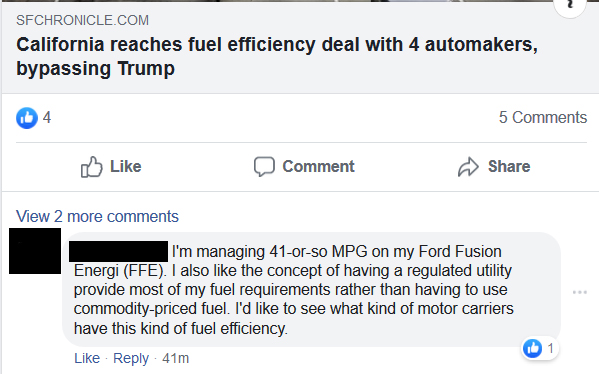People who know nothing yet pontificating wisely, Part who the hell knows what.

The news article is from the San Francisco Chronicle, for what it’s worth.
So let’s get right into this comment, shall we?
“I also like the concept of having a regulated utility provide most of my fuel requirements rather than having to use commodity-priced fuel.”
So in other words, you are in favor of price controls. Price controls don’t work. I remember price controls from the Nixon Administration, when freezing gas prices (particularly after the Arab oil embargo) and other commodity prices simply worked to ensure that there were shortages.
Not so fast, you say; there are lots of government-imposed price controls on things today that don’t result in shortages. How about milk, for instance?
Yeah, milk is cheap on the grocery store shelf, a lot cheaper than it should be, because a) the government provides dairy farmers with price supports that come out of our pockets through taxes, and b) dairy farmers still aren’t making enough even with the price supports, so they produce a fuckton more milk than we need (even for export) and the government obligingly pays (again out of our pockets) to make it into cheese and other dairy products than can be stored long-term, and then pays (again out of our pockets) to maintain huge refrigerated warehouses in which to store said long-term storage items. Tell me again how milk is a bargain.
Generally, if you notice that something is cheap and its price is government-controlled, there is a taxpayer-funded price support going to the pockets of the producers. This is not the case with electricity or gasoline.
And by the way, electricity is as much a commodity as anything else that’s sold. For every megawatthour of electricity purchased off the national or regional grid (which is important for a state like California that does not produce enough electricity to cover its total demand), there are normal rates and peak rates. When electricity demand is high and power from the external grid is scarce, it’s sold at a premium to utilities like PG&E. You may think you have a fixed rate for electricity, leading you to believe that it is not commodity-priced, but believe me, the rate you pay takes those peak “wholesale” rates into account. If it didn’t, PG&E would be in even more trouble than they’re already in.
Also, I think people who are not savvy about such things actually believe that as long as your lights are on, there’s always more electricity where that came from. To me, that’s like believing that as long as you have checks in your checkbook, you’ve got money in the bank. Unfortunately, neither electricity or bank accounts work that way.
In California’s case, where the state government loves electricity but hates traditional electricity producers, moving to more electric cars that require charging points (or apparently in the commenter’s case, buying a hybrid that he’d prefer to charge in his garage at night rather than run the motor to charge the battery, because for some reason he thinks the former would be cheaper) just means users will be making increasing demands on the grid. And the decrepit California grid is already straining to meet demand.
Here’s another story from the 1970’s that may shed light (as it were) on what happens when utilities suddenly have to meet increased demand. Before the 1970’s most middle-class homes did not have air conditioning. (I realize that may come as a shock to millennials.) Suddenly, in the very late 1960’s and early 1970’s, everyone and their brother was getting central air installed.*
And equally suddenly, neighborhoods started experiencing brownouts at peak air conditioning times, for instance, when people got home in the afternoon and turned the air either on or down. Look, before the 1960’s, most middle-class homes had 60 amp service.** And generally, the local power company sized its neighborhood power build-outs to handle x number of homes at no more than 60 amps each. A small central air conditioner (2-1/2 to 3 tons, say, serving a home between 1,200 and 1,500 square feet) used to require a 240V branch circuit of 30 amps. (They’re more efficient now, but this was then.) And they used most of that 30 amps when they started up, then throttled back to maybe 15-20 running amps.
Now factor in house lighting, your electric range, electric water heater, and electric dryer. (We had gas for the last three, but work with me; a lot of the homes in this subdivision had electric cooktops and electric ovens. Dad insisted on gas.)
All of a sudden, your central-air-conditioned neighborhood is pulling a lot more power than it used to. And that’s going to drop the line voltage (which is what causes brownouts), and on a really hot day when the air conditioning units are running full blast, you may even end up dropping out the circuit breakers down the street where your neighborhood service enters. That means a power company truck roll to reset the breakers (they’re manual) and a lot of frantic engineering down at the power company to figure out how they can supply enough power to your neighborhood to prevent that in the future.
So back to California. Let’s add a Level-2 charger to your garage for your Ford Fusion Energi. Surprise! According to this website, you need a 50 amp, 240 volt circuit to supply enough power to your new charger to charge your car. And that circuit is going to run at 80% capacity, so you’ve just added 40 amps of load to your home electrical service. For those playing along at home, that’s 9.6 kilowatts. So how many homes are in your neighborhood? If they all install a Level 2 charger, that’s nearly 10KW per house, and I will just about guarantee that your electric utility is going to have a conniption when everyone comes home and plugs in their cars.***
And you’re going to do that, because as previously noted, the electric utility is regulated and the state tells them how much they can charge you for a kilowatt hour of electricity. So your cost is, again as previously noted, fixed, whereas the cost to the electric utility just went up because of upgrades and the fact that electric power is in fact a commodity that is purchased from the excess produced by other utilities on the grid. But in California, you hate the kind of power plants that can actually produce, day after day, the kind of high power you need to maintain a high-technology civilization. So because your solar plants and wind plants don’t produce enough consistent power to feed that civilization’s hungry maw, even though you still have a few coal and oil plants, and a couple of nukes, and a bunch of hydroelectric dams, you still have to buy a lot of power from out of state. And that power often is sold to you at peak rates — because it’s a commodity, and a lot of times it’s less plentiful than at other times, so the price fluctuates.
So I think we’ve established that the Facebook commenter, above, hasn’t got a clue that his “regulated” electric power is actually a commodity for which he pays full price, whether he knows it or not.
Let’s turn now to his other blithe off-the-cuff question:
“I’d like to see what kind of motor carriers have this kind of efficiency.”
Proving, again, that he is clueless. Motor carriers run diesel (mostly), as do locomotives. They do so at reasonable efficiency for what they are, despite all the emission controls they’re forced to run that decrease horsepower. But their actually mile-per-gallon efficiency is not nearly as important as what it actually costs to transport x tons of freight hundreds or thousands of miles. I’ve seen articles (which I am not going to bother to go find, try Google) suggesting that a hundred-car rail consist with four locomotives pulling it is more efficient in terms of ton-miles per gallon of fuel than a corresponding number of trucks running the same amount of freight. But even if that’s true, a big over-the-road truck pulling a tandem-axle trailer that can carry a maximum of 34,000 pounds (17 tons) is going to be far more efficient than a hybrid automobile that is not going to get anywhere near 40mpg if you load it down. (And let’s see you put more than a couple of hundred pounds of stuff in a small hybrid. Not going to happen.) At that point, you’re arguing apples and oranges, and the comment doesn’t even make sense after you think about it for a few seconds.
Yeah, it would be great it a diesel semi-tractor could get 40MPG on diesel while pulling 17 tons of freight. Shipping costs would plummet. My friend who works at Cummins would be thrilled. But that’s just not going to happen. Diesel semi-tractors average between 4-8 MPG. But that doesn’t matter when you’re pulling 17 tons to the MAYBE 1/10 ton you can jam into the back seat and trunk of your hybrid car. Your hybrid may indeed average 5 to 10 times the MPG of a semi-tractor, but the semi-tractor can pull ONE HUNDRED AND SEVENTY TIMES as much stuff as your hybrid. I’ll leave the ton/mile/gallon math as an exercise for the reader, but even without the math, it’s pretty clear that for its intended purpose, a semi-tractor is a buttload more efficient than a hybrid automobile.
So, Facebook commenter, your arguments are both invalid. Try doing some basic research before you say stupid shit in the future.
As if that will happen.
_________________
* I can vouch personally for this because my father was in the business back then, and I was old enough to be a sort of apprentice.
** Again, you can trust me on that, in my lifetime I’ve upgraded more 60 amp services to 100 or 200 amps than I care to think about in my old age.
*** As a comparison, a well-insulated house in north-central Indiana requires about 45 BTUh per square foot. A well-insulated 1500-square foot house thus requires about 67,500 BTUh for normal heating. To get 68,000 BTUh requires 20KW of electric heat. So your Level 2 charger requires enough electricity to heat an 800 square foot home (think “two-bedroom apartment”) for 4 to 5 hours. In fairness, furnaces don’t run 24/7 unless it’s REALLY cold, but generally estimators assume they’ll run about half the time in the winter. Consider, then, that your Level 2 charger will require enough electricity to heat a typical two-bedroom apartment on a mild winter day. Is this still efficient? And if your electricity is generated by coal, oil, or natural gas, is it still clean and green like you want to think it is?

Too bad the the Big 3 did not have the balls to tell California to screw off in the 1960’s when the state decided to implement their own CAFE standards. We would not be in this mess today. Car companies would not be spending BILLIONS to develop electric cars that will only service those who drive short distances and self-driving cars no one wants except the Ubers, Lyfts and the same people who think public transportation is great — for others.
Even today I wish one of the auto companies would just tell the west coast to eat me and concentrate on the other 49 and Canada.
Of course the libs in the media would roast them and nothing scares a CEO more than bad press.